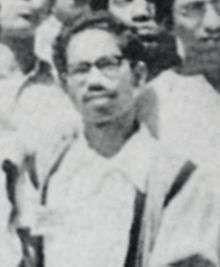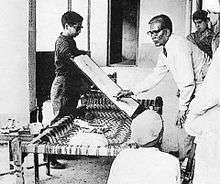Murtaja Baseer
| Murtaja Baseer | |
|---|---|
 Baseer in 1954 | |
| Native name | মুর্তজা বশীর |
| Born |
17 August 1932 Dacca, Bengal Presidency, British India |
| Nationality | Bangladeshi |
| Alma mater | |
| Occupation | Painter |
| Parent(s) |
|
| Relatives | Muhammad Takiullah (brother) |
| Awards | Ekushey Padak |
Murtaja Baseer (born 17 August 1932) is a Bangladeshi painter.[1] He is also a poet, short story writer, novelist, researcher, numismatist and filmmaker.[2][3] He was awarded Ekushey Padak in 1980 by the Government of Bangladesh.[4]
Early life and education
Baseer was born to Muhammad Shahidullah and Marguba Khatun.[5] Shahidullah was a scholar and a linguist. Baseer enrolled in Dacca Art College (now the Faculty of Fine Arts, University of Dhaka) in 1949. After graduating in 1954, he studied at the Academy of Fine Arts of Florence during 1956-58. Then he studied mosaic and etching at École nationale supérieure des Beaux-Arts (ENSBA) in Paris during 1971–73.[5][6]
Career

Baseer joined University of Chittagong as an assistant professor and served until 1998.[7]
Baseer has written several novels including Ultramarine (1954), Kanch-er Pakhir Gaan (1969), Mitar Shangey Char Shandha and Amitakkhar. He was a regular contributor to now defunct literary journals like Dilruba, Samakal, and Saogat. His first published poem was Parbe Na. He worked as a screenplay writer, art director and chief assistant director for the Bengali film Nodi O Nari (1964), and as an art director for the Urdu film Kaise Kahoon (1965).[1]
Baseer was active in leftist politics during the 1950s and was sent to prison during erstwhile Pakistan government.[8]
In 1987, he received a fellowship from British Council to carry out research on folk and traditional art of Bangladesh. In 1988, he visited several museums in Delhi, Calcutta, Banaras and 3000 villages under nine districts of West Bengal — under the fellowship of Indian Council for Cultural Relations (ICCR). His work Mudra O Shilalipir Aloke Banglar Habshi Sultan O Tothkalin Samaj was published in 2004. Several articles by Baseer was published in the Journal of the Numismatic Society of India.[7]
Awards
- Prix National, Festival of Paintings, Cagnes-sur Mer, France (1973)[9]
- Academy Award by Bangladesh Shilpakala Academy (1975)
- Best Cover Design, National Book Centre, Dhaka (1976)
- Ekushey Padak (1980)
- Sultan Padak, Narail (2003)
- Star Lifetime Award (2016)[7]
References
- 1 2 "Murtaja Baseer turns 80". The Daily Star. August 18, 2011. Retrieved February 11, 2016.
- ↑ "Daily Star honours 25 scholars, nation builders". The Daily Star. 2016-02-05. Retrieved 2017-11-25.
- ↑ Ahmed, Monwar (1993). Bhasha Andoloner Sochitro Dolil. Dhaka: Agamee Prokashani. pp. 90–91. ISBN 984-401-147-7.
- ↑ "একুশে পদকপ্রাপ্ত সুধীবৃন্দ" [Ekushey Padak winners list] (in Bengali). Government of Bangladesh. Retrieved 23 August 2017.
- 1 2 Siddiqua, Fayeka (30 September 2016). "In Conversation with Murtaja Baseer". The Daily Star. Retrieved 30 September 2016.
- ↑ "Tale of a butterfly man: A conversation with Murtaza Bashir". The Daily Star. 2017-08-17. Retrieved 2018-07-17.
- 1 2 3 "Murtaja Baseer". The Daily Star. 5 February 2016. Retrieved 1 February 2016.
- ↑ "Murtaja Baseer recalls the Language Movement". The Daily Star. February 22, 2012. Retrieved February 11, 2016.
- ↑ "Murtaja Baseer". Bengal Foundation. Retrieved 2017-11-29.
External links
- Murtaja Baseer on IMDb
- Selim, Lala (2007). Cultural Survey of Bangladesh: Art and Crafts (First ed.). Bangladesh: Asiatic Society of Bangladesh.